-
ARTÍCULO ORIGINAL09/05/2022
Wise Infant Development®: creación de un software para la enseñanza de la educación en enfermería pediátrica
Revista Brasileira de Enfermagem. 2022;75(5):e20210466
Resumen
ARTÍCULO ORIGINALWise Infant Development®: creación de un software para la enseñanza de la educación en enfermería pediátrica
Revista Brasileira de Enfermagem. 2022;75(5):e20210466
DOI 10.1590/0034-7167-2021-0466
Visualizações0RESUMEN
Objetivos:
crear una aplicación informática para la enseñanza de la enfermería en la evaluación del desarrollo infantil.
Métodos:
investigación metodológica aplicada, desarrollada en tres etapas: análisis, diseño y desarrollo. Se han adoptado las características de calidad del producto de las normas ISO/IEC 25010. El lenguaje de programación utilizado fue JavaScript. El software educativo se desarrolló en base a una teoría cognitiva constructivista.
Resultados:
fue posible crear el software a partir de las siguientes métricas de calidad: idoneidad funcional, confiabilidad, usabilidad, eficiencia de desempeño, compatibilidad, seguridad, mantenibilidad y portabilidad. La tecnología aborda el desarrollo infantil en los dominios físico, cognitivo y psicosocial y cómo esta evaluación debe llevarse a cabo en Brasil. El software cuenta con pruebas previas y posteriores, 5 módulos de aprendizaje, emisión de certificados, soporte para dudas y panel administrativo. Consideraciones Finales: el software se suma a las herramientas existentes para monitorear el desarrollo infantil, facilitando la adquisición de conocimientos por parte de los estudiantes en la promoción de la salud infantil.
Palavras-chave: Desarrollo InfantilEducación en EnfermeríaEnfermería PediátricaProgramas InformáticosTecnologia EducacionalVer mais -
REFLEXIÓN09/05/2022
Universal health system based on Primary Care and advanced practice nursing
Revista Brasileira de Enfermagem. 2022;75(5):e20210403
Resumen
REFLEXIÓNUniversal health system based on Primary Care and advanced practice nursing
Revista Brasileira de Enfermagem. 2022;75(5):e20210403
DOI 10.1590/0034-7167-2021-0403
Visualizações0Ver maisABSTRACT
Objective:
To reflect on advanced practice nursing in Primary Health Care considering the complexity of the Brazilian health system.
Methods:
Reflective study, based on the document “Expanding the role of nurses in Primary Health Care” and anchored in the literature and critical analysis of the authors.
Results:
Due to the complexity of the Unified Health System — in terms of infrastructure, human resources, funding — it is important for Brazil to carry out its own systematic process of discussion on the implementation of advanced practice nursing, considering the context of the current health care model, to define the role of this practice according to the characteristics of a universal health system and not a universal health coverage. Final considerations: The expansion of the workforce and the insertion of advanced practice nursing in Brazilian Primary Health Care needs to happen with greater recognition and incentives for the actions performed at this level of care. For example, they must occur through integration between professionals and the community in health promotion actions, with the availability of appropriate technologies for the work, in order to guarantee the quality and resolution of Primary Health Care.
-
ARTÍCULO ORIGINAL09/05/2022
Beyond technology: Can artificial intelligence support clinical decisions in the prediction of sepsis?
Revista Brasileira de Enfermagem. 2022;75(5):e20210586
Resumen
ARTÍCULO ORIGINALBeyond technology: Can artificial intelligence support clinical decisions in the prediction of sepsis?
Revista Brasileira de Enfermagem. 2022;75(5):e20210586
DOI 10.1590/0034-7167-2021-0586
Visualizações0Ver maisABSTRACT
Objective:
To analyze the critical alarms predictors of clinical deterioration/sepsis for clinical decision making in patients admitted to a reference hospital complex.
Methods:
An observational retrospective cohort study. The Machine Learning (ML) tool, Robot Laura®, scores changes in vital parameters and lab tests, classifying them by severity. Inpatients and patients over 18 years of age were included.
Results:
A total of 122,703 alarms were extracted from the platform, classified as 2 to 9. The pre-selection of critical alarms (6 to 9) indicated 263 urgent alerts (0.2%), from which, after filtering exclusion criteria, 254 alerts were delimited for 61 inpatients. Patient mortality from sepsis was 75%, of which 52% was due to sepsis related to the new coronavirus. After the alarms were answered, 82% of the patients remained in the sectors.
Conclusions:
Far beyond technology, ML models can speed up assertive clinical decisions by nurses, optimizing time and specialized human resources.
-
ARTÍCULO ORIGINAL09/05/2022
Cardiovascular risk among nursing workers: a cross-sectional study
Revista Brasileira de Enfermagem. 2022;75(4):e20210305
Resumen
ARTÍCULO ORIGINALCardiovascular risk among nursing workers: a cross-sectional study
Revista Brasileira de Enfermagem. 2022;75(4):e20210305
DOI 10.1590/0034-7167-2021-0305
Visualizações0Ver maisABSTRACT
Objective:
to assess cardiovascular risk among nursing workers at a public hospital.
Method:
a cross-sectional study, with 324 nursing workers, using a questionnaire composed of two information blocks. The first covered issues related to sociodemographic and occupational and health characteristics, and the second, the Revised Framingham Risk Score (FRS), to stratify cardiovascular risk. To assess work-related psychosocial stress, the Swedish Social Control Demand Scale was used.
Results:
the most prevalent modifiable risk factor for CVDs was waist circumference (75.9%), followed by overweight (43.8%), obesity (29.3%), alcohol consumption (21.9%), lipoprotein cholesterol low density (LDL) > 130 (20.7%) and hypertension (20.4%)
Conclusion:
it was found that 96% of workers had a low risk of developing cardiovascular disease in the next ten years, and male workers aged >40 years with shorter working hours are more likely to have cardiovascular disease.
-
ARTÍCULO ORIGINAL09/05/2022
Factors associated with the skills of informal caregivers in home care
Revista Brasileira de Enfermagem. 2022;75(4):e20210744
Resumen
ARTÍCULO ORIGINALFactors associated with the skills of informal caregivers in home care
Revista Brasileira de Enfermagem. 2022;75(4):e20210744
DOI 10.1590/0034-7167-2021-0744
Visualizações0Ver maisABSTRACT
Objective:
To identify factors associated with cognitive, emotional, psychomotor, and relational skills of informal caregivers in home care.
Methods:
A cross-sectional study carried out with a sample of 216 informal caregivers residing in a municipality in the state of Paraná. Data collection took place between February and July 2019, with an instrument developed and validated to assess the skills of informal caregivers. Descriptive and inferential analyses were used.
Results:
The factors associated with a greater competence of informal caregivers were being female, having training in the field, and having more than five years home care experience. The lowest competence was observed in caregivers who had health problems and belonged to the lowest strata of family purchasing power. Participants had lower scores in psychomotor competence and had better results in cognitive competence.
Conclusion:
It was found that women with experience in care had higher levels of competence to provide quality care at home assistance services.
-
ARTÍCULO ORIGINAL09/05/2022
Content analysis of the nursing diagnosis “Excess fluid volume (00026)” in renal patients
Revista Brasileira de Enfermagem. 2022;75(4):e20210058
Resumen
ARTÍCULO ORIGINALContent analysis of the nursing diagnosis “Excess fluid volume (00026)” in renal patients
Revista Brasileira de Enfermagem. 2022;75(4):e20210058
DOI 10.1590/0034-7167-2021-0058
Visualizações0Ver maisABSTRACT
Objective:
To analyze the content of the conceptual and operational definitions of the related factors, associated condition and defining characteristics of the nursing diagnosis “Excess fluid volume (00026)” in hemodialysis renal patients.
Methods:
Methodological study, of the content analysis type, with 49 specialists who reached a score equal to or greater than 5, according to Fehring’s criteria. Thirty elements were evaluated for relevance, clarity, and precision. The experts’ profile was analyzed using descriptive statistics, and the binomial test analyzed the agreement between them in relation to the terms.
Results:
The main validated indicators were “Oliguria”, “Anasarca”, “Paroxysmal nocturnal dyspnea”, “Dyspnea”, “Change in blood pressure”, “Edema”, “Ingestion greater than elimination” and “Increased central venous pressure”. This shows that this phenomenon is present in this population.
Conclusion:
29 elements were validated for relevance, clarity, and precision. This result clarifies the terms that make up the phenomenon, providing a better understanding of the concept; and assists in the accurate diagnostic proposition.
-
ARTÍCULO ORIGINAL09/05/2022
Validation of Ludic-Quest to the playfulness of health games: gameplay and emotions on the field
Revista Brasileira de Enfermagem. 2022;75(4):e20210822
Resumen
ARTÍCULO ORIGINALValidation of Ludic-Quest to the playfulness of health games: gameplay and emotions on the field
Revista Brasileira de Enfermagem. 2022;75(4):e20210822
DOI 10.1590/0034-7167-2021-0822
Visualizações0Ver maisABSTRACT
Objective:
to validate Ludic-quest construct and reliability to assess game playfulness, through latent factors in gameplay, perception of learning and emotions in the game.
Methods:
a cross-sectional study to validate the instrument’s psychometric properties. 247 people responded to the questionnaire after a match in the game Violetas. Exploratory Factor Analysis, using KMO (>0.7), Bertlett (p=0.005), Varimax and factor loading (>0.6). Reliability by Cronbach’s alpha (>0.6).
Results:
in gameplay/learning, KMO=0.859, Bertlett significant. The eigenvalue indicated four factors (reflections; immersion; challenges; aesthetics), 10 retained variables. In the factor analysis of emotions: KMO=0.817; Bartlett p=0.000. Extraction of four factors (pleasure; ostraenie; tension; fun), 10 retained variables. The 20 validated variables contain reliability (Cronbach’s alpha=0.716).
Conclusions:
the eight validated factors centralize playfulness in health game production, composing a reliable playfulness assessment instrument for use in research.
-
06/05/2022
Carta ao Editor
Revista Brasileira de Enfermagem. 2022;75(6):e2022750602c
Resumen
Carta ao Editor
Revista Brasileira de Enfermagem. 2022;75(6):e2022750602c
DOI 10.1590/0034-7167.2022750602c
Visualizações0Ilma. Sra.Profa. Dra. Dulce Aparecida Barbosa, Editora-Chefe Revista Brasileira de Enfermagem[…]Ver mais
-
14/04/2021
Child behavior during the social distancing in the COVID-19 pandemic
Revista Brasileira de Enfermagem. 2021;74:e20200762
Resumen
Child behavior during the social distancing in the COVID-19 pandemic
Revista Brasileira de Enfermagem. 2021;74:e20200762
DOI 10.1590/0034-7167-2020-0762
Visualizações0Ver maisABSTRACT
Objective:
To describe the daily activities performed by children from 6 to 12 years of age incomplete and analyze children’s behavior during social distancing in the face of the COVID-19 pandemic.
Methods:
Cross-sectional study with children in a learning stage living in Brazil. The data were collected via online form. Fisher’s exact test was applied to analyze the association of categorical variables with child behavior; when significant, it was used the odds ratio. It was considered results considered statistically significant those presenting values of p < 0.05.
Results:
Data from 530 children were analyzed: 50.3% female, 71.3% from the Southeast Region, 73% in fulltime social distancing, 52% presented anxiety, which was significantly associated with changes in sleep and appetite.
Conclusion:
The results indicate the need for parents/caretakers to stimulate moments for the child to express themselves, not minimizing their feelings and providing emotional support to mitigate the negative impact of these feelings on the child’s mental and physical health.
-
05/12/2019
Hospital care and urinary incontinence in the elderly
Revista Brasileira de Enfermagem. 2019;72:284-293
Resumen
Hospital care and urinary incontinence in the elderly
Revista Brasileira de Enfermagem. 2019;72:284-293
DOI 10.1590/0034-7167-2018-0273
Visualizações0Ver maisABSTRACT
Objective:
to identify factors inherent in hospital care that favor urinary incontinence in the elderly.
Method:
an integrative review with Scopus, CINAHL and Pubmed searches. Includes original articles, no language restriction, published between 2008 and 2018. Rated level of recommendation and level of evidence were assessed using the Oxford Center for Evidence-Based Medicine classification. Exploited content through thematic analysis in light of the Donabedian model.
Results:
13 articles constituted the sample. There were factors such as the unjustified and indiscriminate use of devices such as the geriatric diaper; hospital structure adversely affecting the needs of the elderly; and deficit in screening, risk identification and underreporting of the problem favor urinary incontinence in the hospitalized elderly.
Conclusion:
modifiable factors related to hospital structures and care processes favor both the onset and worsening of urinary incontinence in the elderly.
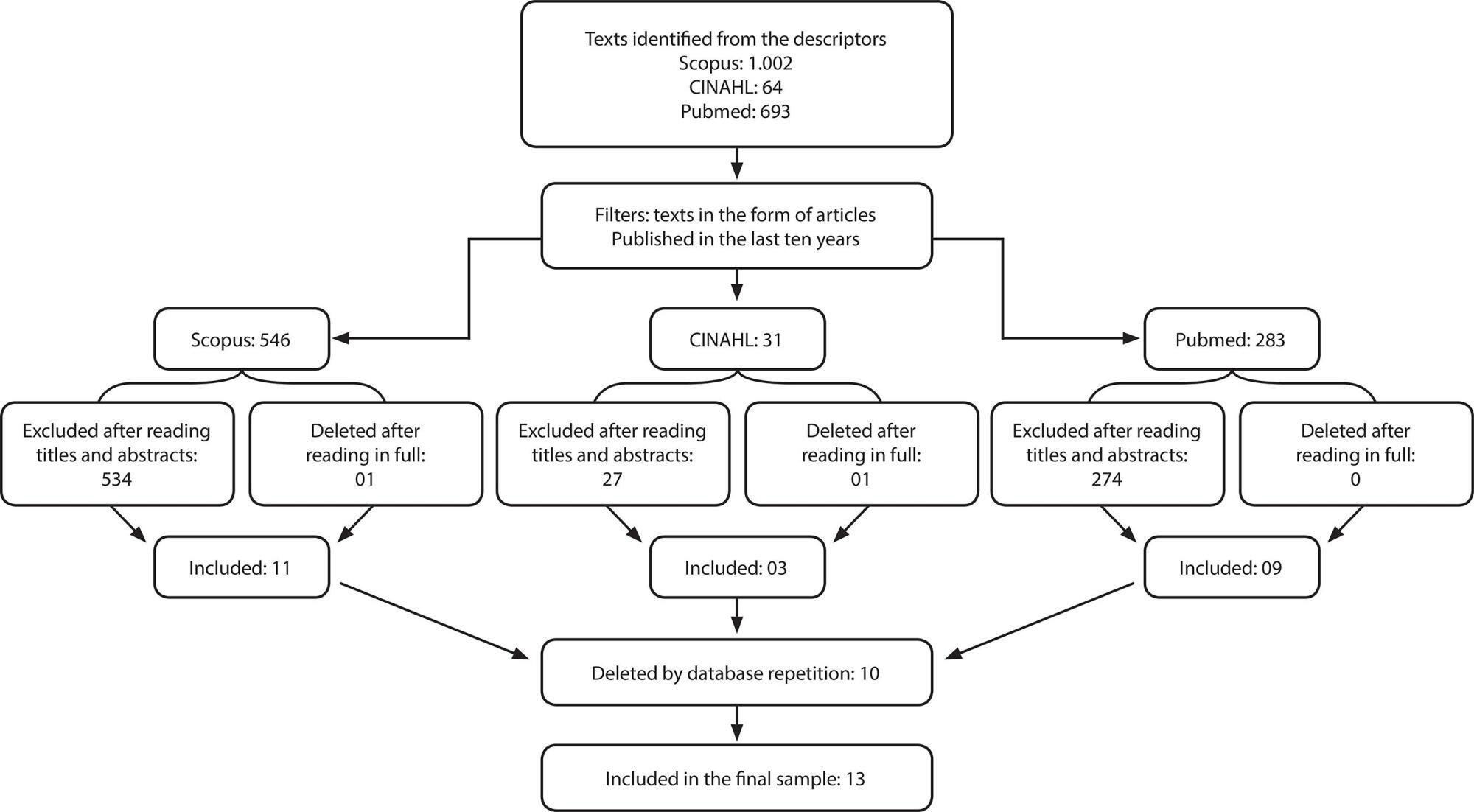
-
ARTÍCULO ORIGINAL21/10/2019
Hipermídia educativa sobre assistência de enfermagem ao parto: construção e validação de conteúdo e aparência
Revista Brasileira de Enfermagem. 2019;72(6):1471-1478
Resumen
ARTÍCULO ORIGINALHipermídia educativa sobre assistência de enfermagem ao parto: construção e validação de conteúdo e aparência
Revista Brasileira de Enfermagem. 2019;72(6):1471-1478
DOI 10.1590/0034-7167/2018-0163
Visualizações1Ver maisRESUMO
Objetivo:
construir uma hipermídia educativa sobre a assistência de enfermagem ao parto de risco habitual e realizar a validação de conteúdo e de aparência.
Método:
pesquisa metodológica, realizada seguindo as seguintes etapas: levantamento do conteúdo e planejamento dos módulos; produção das mídias e organização das unidades tutoriais; organização do espaço do aluno, tutor e de comunicação entre eles; elaboração da hipermídia; disponibilização da hipermídia; avaliação por especialistas em Enfermagem e Informática; e implementação das sugestões propostas.
Resultados:
a hipermídia educativa mostrou-se como um material validado, visto que apresentou um ótimo índice de validade de conteúdo global de 0,97 e significância estatística no teste binomial para o conteúdo e aparência.
Conclusão:
acredita-se que o uso deste material com alunos da graduação em Enfermagem contribuirá com a qualidade da assistência obstétrica, tendo em vista que se constitui em uma tecnologia ilustrada capaz de favorecer o ensino-aprendizagem sobre parto normal humanizado.
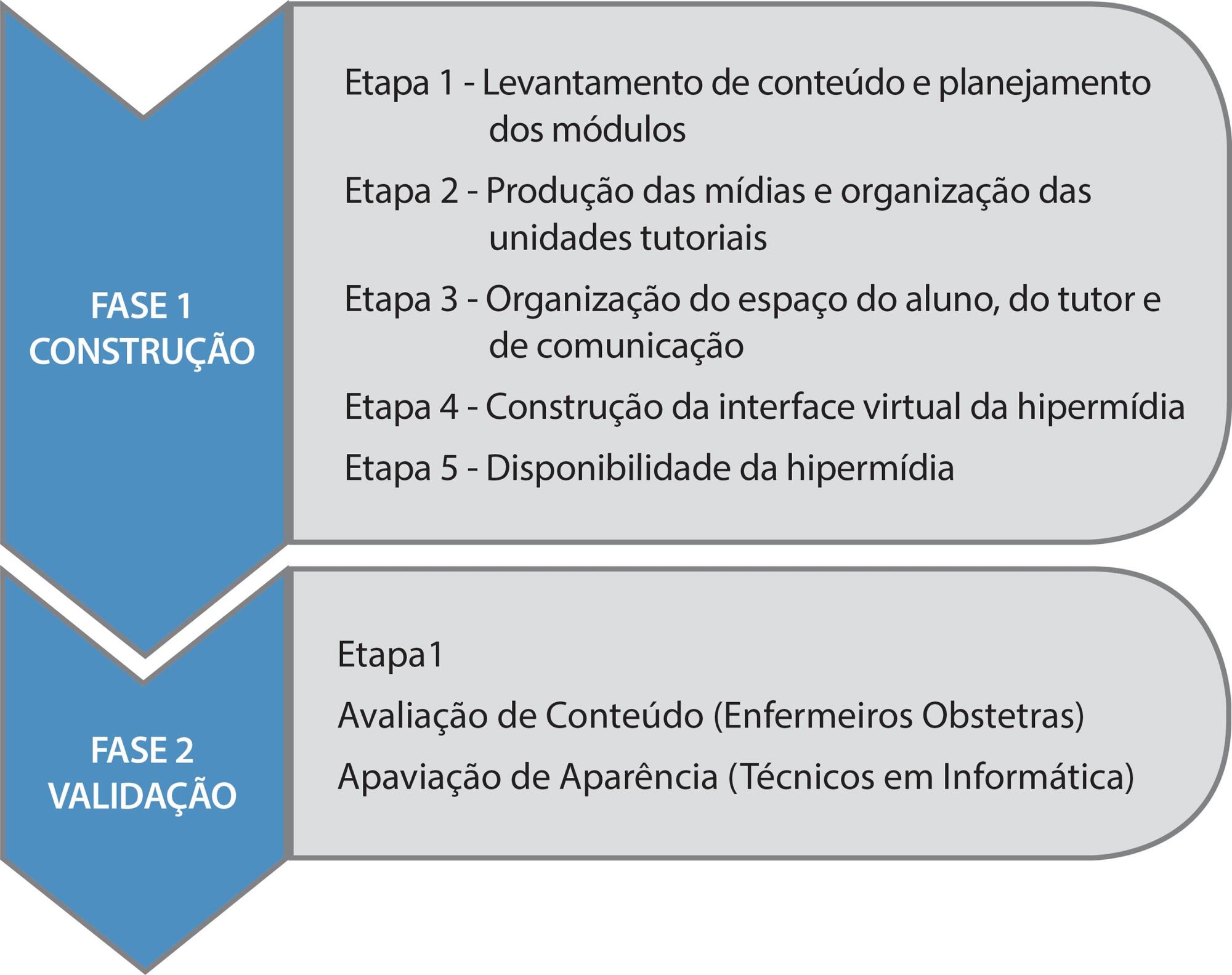
-
ARTÍCULO ORIGINAL30/03/2020
Boas Práticas de segurança nos cuidados de enfermagem em Terapia Intensiva Neonatal
Revista Brasileira de Enfermagem. 2020;73(2):e20180482
Resumen
ARTÍCULO ORIGINALBoas Práticas de segurança nos cuidados de enfermagem em Terapia Intensiva Neonatal
Revista Brasileira de Enfermagem. 2020;73(2):e20180482
DOI 10.1590/0034-7167-2018-0482
Visualizações0RESUMO
Objetivos:
identificar a percepção dos profissionais de enfermagem sobre o erro humano nos cuidados de enfermagem na Unidade de Terapia Intensiva Neonatal; analisar as estratégias de Boas Práticas propostas por esses profissionais para a segurança do paciente nos cuidados de enfermagem.
Métodos:
estudo quanti-qualitativo, descritivo. Cenário: Unidade de Terapia Intensiva Neonatal. Participantes: 22 profissionais de enfermagem. Coleta dos dados realizada por meio de entrevistas e submetidos a análise temática.
Resultados:
erro humano nos cuidados de enfermagem, identificando-se perdas de cateteres e erros no processo de medicação; causas para o erro nos cuidados de enfermagem, destacando-se a sobrecarga de trabalho; Boas Práticas para a segurança do paciente nos cuidados de enfermagem, como capacitação profissional e melhorias das condições de trabalho.
Conclusões:
demonstra-se a importância de investir em estratégias de Boas Práticas para a Segurança do Paciente, buscando-se sedimentar a cultura de segurança organizacional e estimular um ambiente propício ao gerenciamento do erro.
Palavras-chave: EnfermagemErros MédicosGestão de SegurançaSegurança do PacienteUnidades de Terapia Intensiva NeonatalVer mais -
ARTÍCULO DE REVISIÓN29/09/2022
Nursing students’ learning from involvement in research projects: an integrative literature review
Revista Brasileira de Enfermagem. 2022;75(1):e20210053
Resumen
ARTÍCULO DE REVISIÓNNursing students’ learning from involvement in research projects: an integrative literature review
Revista Brasileira de Enfermagem. 2022;75(1):e20210053
DOI 10.1590/0034-7167-2021-0053
Visualizações0Ver maisABSTRACT
Objective:
To identify the learning outcomes and skills obtained of undergraduate nursing students involved in research projects.
Methods:
This was an integrative literature review, based on a research protocol in the CINAHL Complete databases; Cochrane Central Register of Controlled Trials; Cochrane Database of Systematic Reviews; Cochrane Methodology Register; MedicLatina; MEDLINE, Scopus and JBI, including primary and secondary studies, published between 2015 and 2020.
Results:
A total of five heterogeneous articles were included, which were categorized using Kirkpatrick’s (adapted) model. Seventeen learning outcomes acquired through participation in research projects were identified, from the learning of new knowledge and skills to the development of new attitudes and behaviors.
Final considerations:
The involvement of nursing students in research projects is important to their professional development. Future investment in research on this topic can help cement the potential of this type of student involvement.
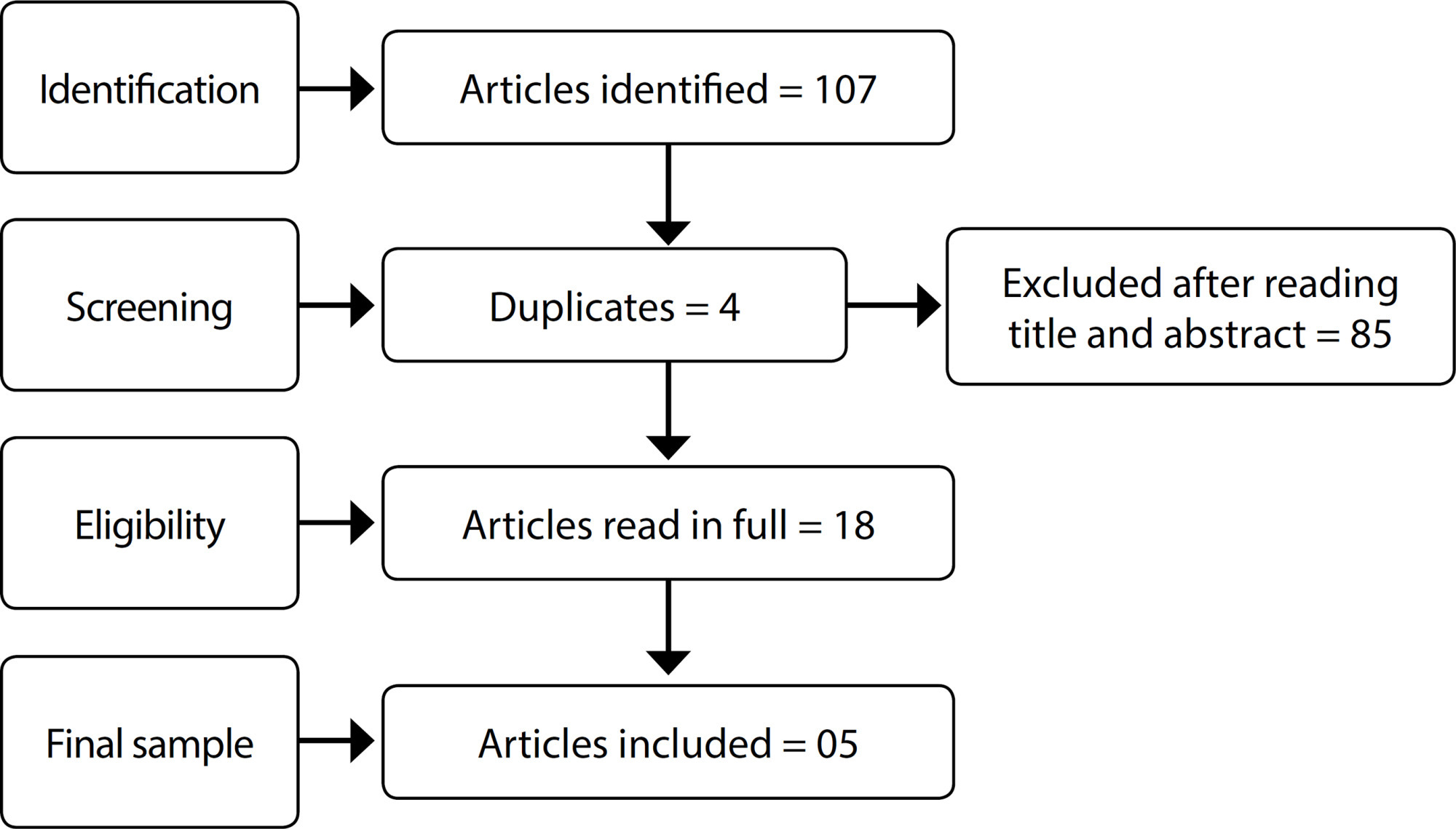
-
ARTÍCULO ORIGINAL05/12/2019
Qualidade de vida relacionada à saúde em pacientes com insuficiência cardíaca
Revista Brasileira de Enfermagem. 2019;72:140-146
Resumen
ARTÍCULO ORIGINALQualidade de vida relacionada à saúde em pacientes com insuficiência cardíaca
Revista Brasileira de Enfermagem. 2019;72:140-146
DOI 10.1590/0034-7167-2018-0368
Visualizações1RESUMO
Objetivo:
Avaliar a qualidade de vida relacionada à saúde dos pacientes com insuficiência cardíaca e relacionar aos dados sociodemográficos e clínicos.
Método:
Trata-se de estudo observacional, de corte transversal, com abordagem quantitativa realizado em ambulatório de insuficiência cardíaca no estado de Pernambuco.
Resultados:
Na amostra (n=101) houve predominância de homens, maiores de 60 anos, casados, profissionalmente inativos. A qualidade de vida relacionada à saúde, a partir do questionário Minnesota Living With Heart Failure Questionnaire foi considerada moderada (34,3±21,6), apresentando relação significativa com idade (p=0,004), classe funcional (p<0,001) e em pacientes com cardiopatia chagásica (p=0,02).
Conclusão:
A qualidade de vida no grupo IC de etiologia chagásica esteve mais comprometida, especialmente na dimensão emocional. Sugere-se a realização de estudos abordando as hipóteses de que maior tempo de acompanhamento ambulatorial melhora a qualidade de vida e que ter doença de Chagas interfere negativamente na qualidade de vida de pacientes com insuficiência cardíaca.
Palavras-chave: Assistência AmbulatorialDoença de ChagasEnfermagemInsuficiência CardíacaQualidade de VidaVer mais -
ARTÍCULO DE REVISIÓN21/12/2020
Aplicação da metodologia Lean Seis Sigma nos cenários de assistência à saúde: revisão integrativa
Revista Brasileira de Enfermagem. 2020;73:e20190861
Resumen
ARTÍCULO DE REVISIÓNAplicação da metodologia Lean Seis Sigma nos cenários de assistência à saúde: revisão integrativa
Revista Brasileira de Enfermagem. 2020;73:e20190861
DOI 10.1590/0034-7167-2019-0861
Visualizações0RESUMO
Objetivo:
analisar a produção científica sobre os resultados da metodologia Lean Six Sigma nas instituições de assistência à saúde.
Métodos:
revisão integrativa da literatura, com a seguinte pergunta: quais são os resultados nas instituições de saúde com a utilização da metodologia Lean Six Sigma e Six Sigma? A busca foi realizada nas bases de dados MEDLINE, LILACS, BDENF, CINAHL, Web of Science e Scopus, sem recorte temporal.
Resultados:
foram incluídos 34 artigos, publicados entre 2005 e 2019, sendo 52,9% provenientes dos Estados Unidos da América. As melhorias mais comumente encontradas foram em instituições hospitalares e na perspectiva dos clientes e processos internos.
Conclusão:
a utilização da metodologia Lean Six Sigma se demonstrou eficaz nos diversos cenários de assistência à saúde, se destacando uma lacuna em sua aplicação quanto ao engajamento e capacitação de pessoas.
Palavras-chave: Administração em SaúdeAssistência à SaúdeControle de QualidadeGestão da Qualidade TotalMelhoria de QualidadeVer mais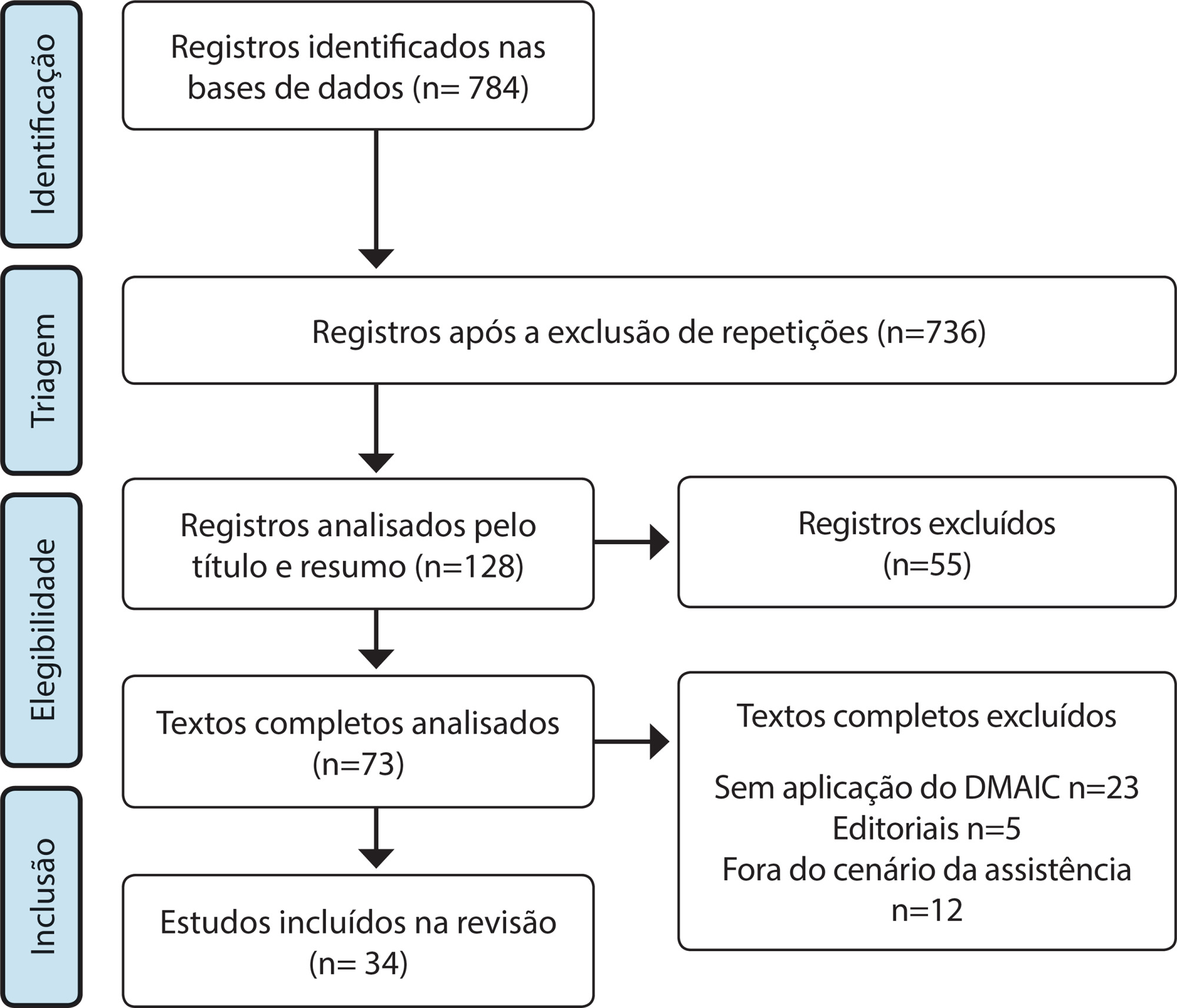
-
ARTÍCULO ORIGINAL17/02/2020
Análise dos registros de técnicos de enfermagem e enfermeiros em prontuários
Revista Brasileira de Enfermagem. 2020;73(2):e20180542
Resumen
ARTÍCULO ORIGINALAnálise dos registros de técnicos de enfermagem e enfermeiros em prontuários
Revista Brasileira de Enfermagem. 2020;73(2):e20180542
DOI 10.1590/0034-7167-2018-0542
Visualizações0RESUMO
Objetivos:
analisar as principais não conformidades dos registros de enfermagem de um hospital público do Nordeste na cidade de Natal.
Métodos:
estudo descritivo, transversal, abordagem quantitativa. Realizado em enfermarias médicas e cirúrgicas. Amostra composta de 120 prontuários de pacientes internados entre outubro e dezembro de 2016. Os dados obtidos foram tabulados e analisados por estatística simples em frequência absoluta e relativa com o software Microsoft Excel 2013. Para avaliar as não conformidades dos registros, usou-se o Diagrama de Pareto.
Resultados:
como principais problemas nos registros de enfermagem, destacou-se a ausência da categoria profissional e número do conselho, responsáveis por 41,8% das não conformidades nos registros de técnicos de enfermagem, enquanto nas anotações dos enfermeiros foram a ausência de hora e as letras ilegíveis, com 61,2%.
Conclusões:
o estudo evidenciou que os profissionais de enfermagem realizam seus registros de forma incompleta e que muitas vezes não documentam o cuidado prestado.
Palavras-chave: ComunicaçãoEnfermagemPesquisa sobre Serviços de SaúdeRegistros de EnfermagemSegurança do PacienteVer mais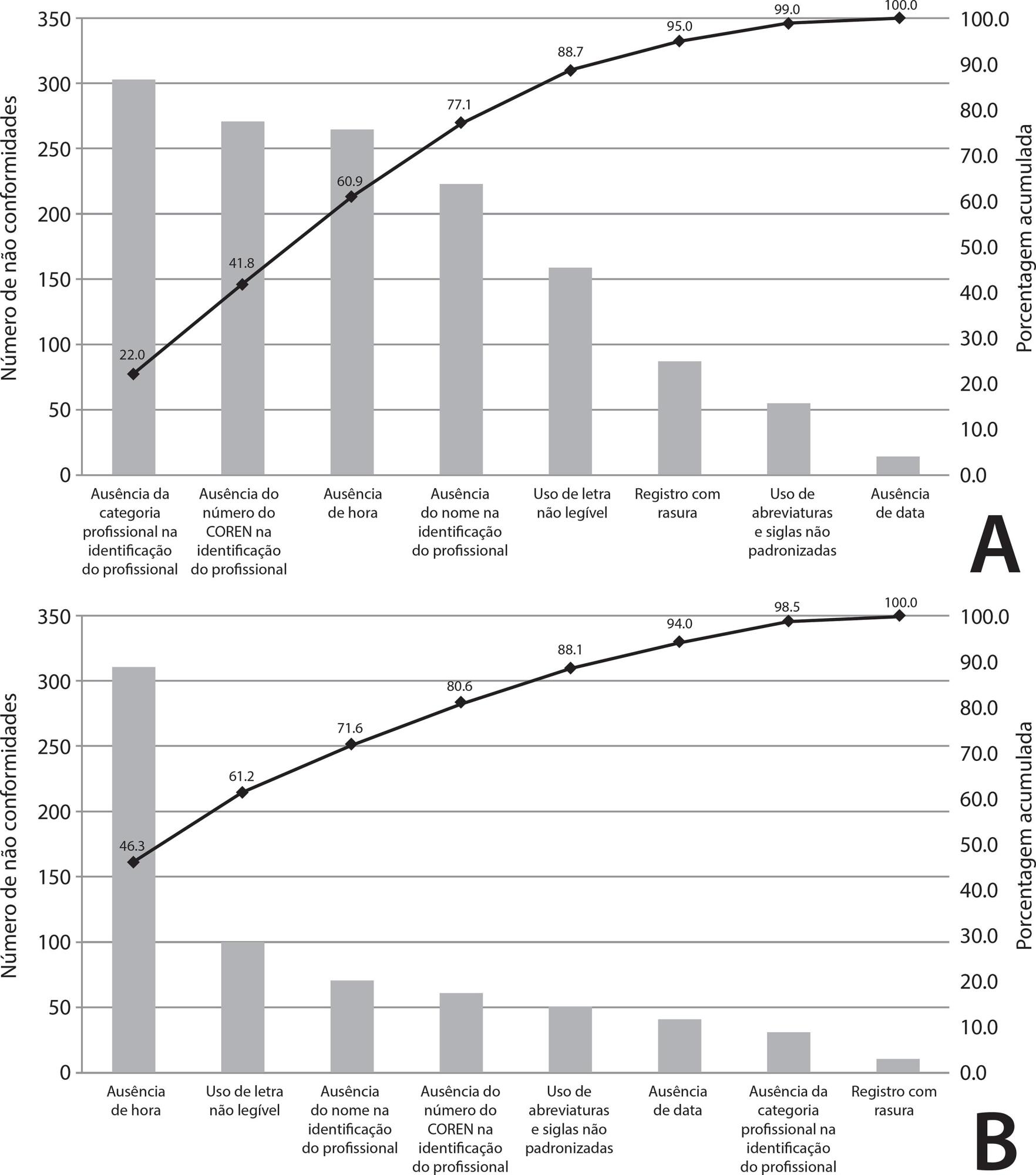
Búsqueda
Buscar en:
Nuvem de Tags
Adolescente (85) Atenção Primária à Saúde (239) COVID-19 (91) Criança (91) Cuidados de Enfermagem (269) Educação em Enfermagem (151) Educação em Saúde (139) Enfermagem (930) Enfermagem Pediátrica (86) Estudantes de Enfermagem (77) Estudos de Validação (131) Família (87) Idoso (208) Promoção da Saúde (99) Qualidade de Vida (104) Saúde do Trabalhador (86) Saúde Mental (145) Saúde Pública (82) Segurança do Paciente (150) Tecnologia Educacional (100)



